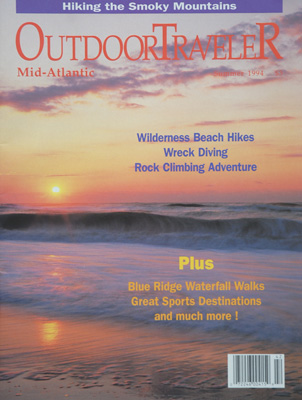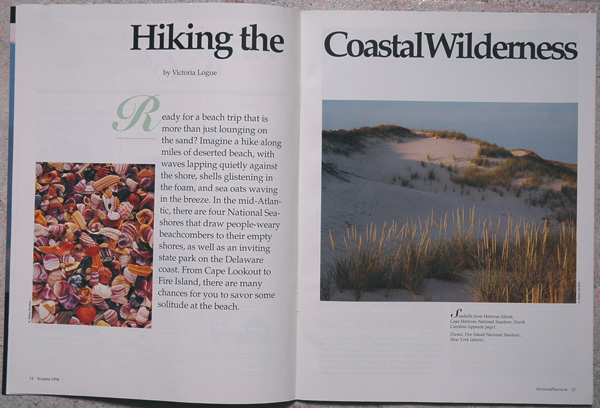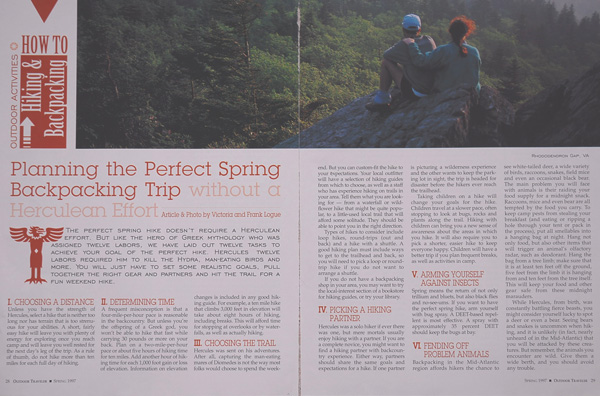  |
|||||
| Home | Books | Redemption - New Novel | |||
|
|
I began my writing career in 1984 as a staff writer for the Warner Robins Daily Sun for whom I earned awards from the Georgia Press Association for my feature writing and my personal column. My work on the Georgia Special Olympics was honored by that group as well. I went on to work as a staff writer for The Rome News Tribune before going freelance. Since then I have written for a variety of regional and national magazines including Backpacker, Blue Ridge Country, and American Hiker. In 1994, I became a contributing editor for Outdoor Traveler: Mid-Atlantic and wrote two articles for their premier issue and that magazine's first four cover stories. One of the stories my husband, Frank, and I wrote for them, Planning the Perfect Spring Backpacking Trip, is reproduced below the scans of my work for the premier issue (at left). |
||||
|
Planning the Perfect Spring Hike
by Victoria and Frank Logue The perfect Spring hike doesn't require Herculean effort. But like the hero of Greek mythology who was assigned twelve labors, we have laid out twelve tasks to achieve your goal of the perfect hike. Hercules' twelve labors required him to kill the Hydra, man-eating birds and more. You'll just have to set some realistic goals, pull together the right gear and partners and hit the trail for a fun weekend hike. I. How Far to Hike II. How Long Will it Take
III. Which Trail
Types of hikes to look at include loop hikes, roundtrips and a hike with a shuttle. A good hiking plan must include how to get to the trailhead and back, so you'll need to pick a loop or roundtrip (out and back) hike if you don't want to arrange a shuttle. If you don't have a backpacking shop in your area, you may want to try the local interest area of the bookstore for hiking guides or your library. IV. Picking a Hiking Partner
Taking children on a hike will change your goals for the hike. Kids travel at a slower pace, often stopping to look at bugs, rocks, and plants along the trail. Hiking with your children can bring you a new sense of awareness about the areas you hike in. It will also require that you pick a shorter, easier hike to keep everyone happy. Kids will have a better trip if you plan frequent breaks, as well as activities in camp. V. Arming Yourself Against Insects
VI. Fending off Problem Animals
While Hercules was constantly battling fierce beasts from birth when he destroyed two large serpents, you might consider yourself lucky to spot a deer or even a bear. Seeing bear and snakes is uncommon when hiking and it is even less likely (in fact, nearly unheard of in the Mid-Atlantic) that you will be attacked by these creatures. Remember, the animals you encounter are wild. Give them a wide berth and you should avoid any trouble. VII. First Aid
VIII. Clothing
IX. Food
For breakfast, oatmeal or instant grits are easy hot meals. Toaster pastries or breakfast bars are fine with a cup of hot chocolate or coffee. At lunch, you will want something easy so you don't have to spend the middle of the day preparing and cleaning up a meal. Lunch foods that pack well are hard cheeses and sausage as well as pita bread and dried fruits. Don't forget to make up a bag of trail mix with your own blend of raisins, nuts, sunflower seeds, cereal (such as Cheerios) and candy (such as M&Ms) for a mid-day energy boost that even a mythological hero would envy. X. Gear
Either an internal or external frame pack will work well if it is sized right for the equipment carried without having too much extra room. A padded hipbelt with quick release buckle and padded shoulder straps are also essential. With an internal frame pack, fit is even more important. Before using a new pack, have someone familiar with the pack assist you in adjusting the straps to fit your build. A good backpacking tent is lightweight and weatherproof, with a rainfly extending to within a few inches of the ground. It should not weigh more than four pounds per person. The hiker not carrying the tent carries other communal gear, such as a stove and food, to offset the weight. A sleeping bag should be rated for about 20 degrees or less for spring hiking, when temperatures still plummet in the mountains. The bag needs to have a well-insulated draft tube covering the zipper. To maximize your bag's insulating potential, change out of the clothes you hiked in. The moisture locked in these clothes will wick away heat as they dry themselves. A sleeping pad is required, not just to soften the effects of sleeping on the ground, but to add a layer of insulation between you and the ground. A backpacking stove should weigh about two pounds. Popular stoves burn a butane-propane blend, white gas, or unleaded fuel. Make sure that you use a stove once at home to familiarize yourself with its workings before relying on it for backcountry use. The outfitter may also be able to rent you gear if you don't have everything required for a backpacking trip. XI. Packing
XII. The Hike
The hiker with the naturally slowest pace should lead. It is much easier for a fast hiker to cut back their pace than for a slower, or younger hiker, to speed up without tiring out. To hike safely, remember this rule: Don't step on anything you can step over; don't step over anything you can step around. Rocks and sticks in the trail are best stepped around or, if too large, over, to avoid falls. Take breaks when you need them, alternating pack-on and pack-off breaks. Taking your pack off breaks your momentum, so you won't want to remove your pack every time you stop to rest. Just lean over with your pack on and hold your knees in your hands to take the weight of the pack off your hips and shoulders. It's true, the tale of your spring hike won't be carved in stone or memorialized on a Grecian urn in a dusty museum. But, with the right planning and preparation, you can have an adventure worth retelling without Herculean effort.
~Copyright 1997 Victoria and Frank Logue
|
|||||
|
|
|||||





